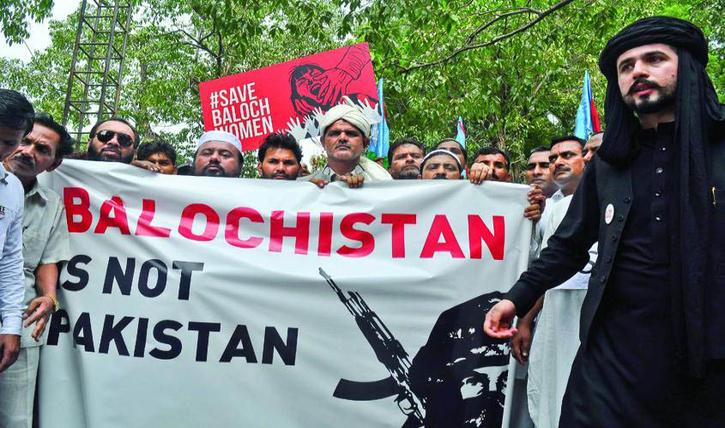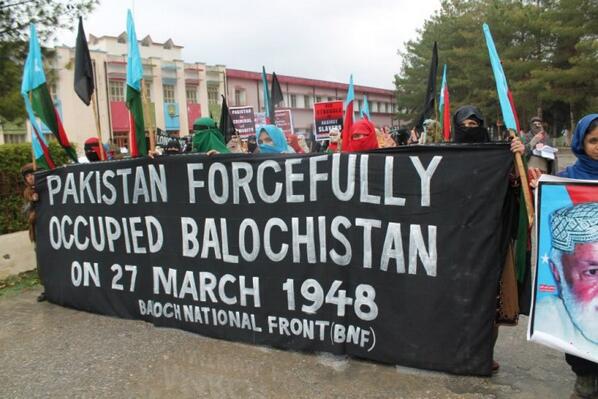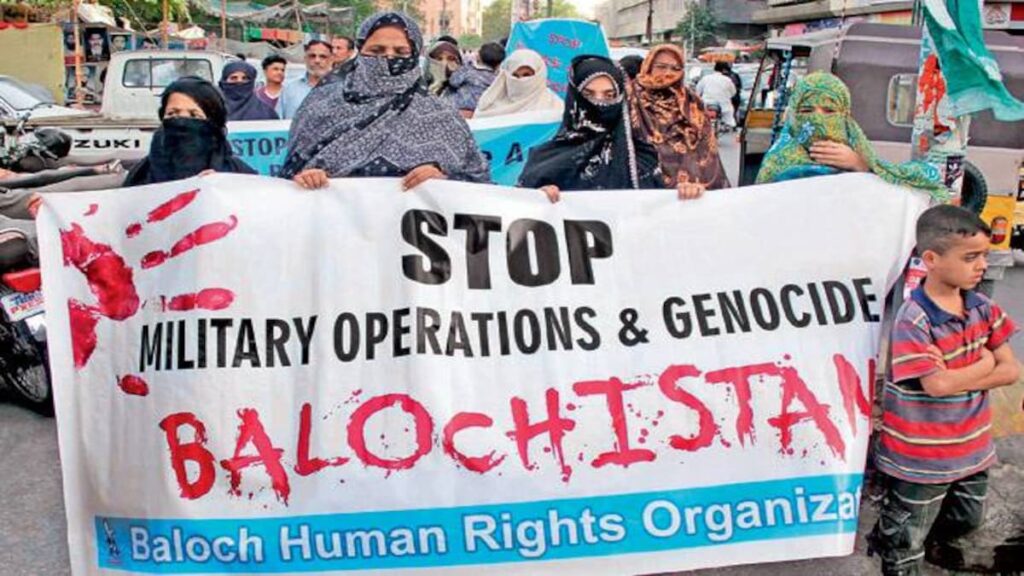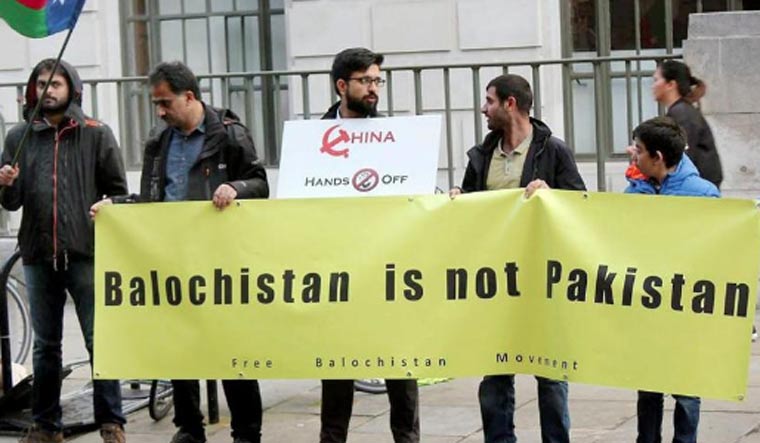
“Today from the ramparts of Red Fort, I want to greet and express my thanks to some people. In the last few days, people of Balochistan, Gilgit, Pakistan-occupied Kashmir have thanked me, have expressed gratitude, and expressed good wishes for me.”
When the Indian Prime Minister acknowledged the people of Balochistan from the ramparts of the Red Fort on Indian Independence Day in 2016, it was followed by a barrage of speculations as to the implications of this apparently benign act of expressing thanks to his well-wishers. When the elected leader of the world’s largest democracy speaks on such an important date in front of a multitude of cameras, every word is carefully measured, and whatever is said, is uttered with a purpose. Comprehending or imagining the worst possible implications of this, Pakistani commentators and analysts went ballistics. Balochistan is a raw nerve for Pakistan, and the situations unfolding there have implications not just for Pakistan but also for India and the wider region, including China. As such, it is imperative to create and engage in discussions around the issue of Balochistan.
Balochistan- A Sorry State of Affairs
From Sarasvati Valley Civilization to Islamic Republic of Pakistan, Balochistan faced a devolution, so to say. Mehrgarh, located in the Kacchi plain of Balochistan is a key site of the Sarasvati Valley Civilization, more famously known as the Indus Valley Civilization (IVC). The earliest evidence of settled human society in South Asia is attributed to Balochistan. It is even argued that the Sarasvati Valley Civilization evolved from Mehrgarh. There are various other archaeological sites as Kot Bala, Nausharo, Pirak, and Sutkagen Dor in Balochistan where discoveries are indicative of the existence of a flourishing highly civilized human society that was a centre of trade, connecting the IVC with Mesopotamia.
At present, Balochistan is the largest province of Pakistan, accounting for more than forty per cent of its total land area, though its share in total population is less than six per cent. Smaller portions of Balochi land are also in Iran’s Sistan and Afghanistan’s Helmand, but the major chunk lies within Pakistan’s international boundary. In terms of natural resources, this land is particularly blessed. Pakistan’s geological survey estimates more than eighty mineral deposits in the region including oil, natural gas, gold, copper, coal, iron, limestone, barytes, chromite etc. The Sui gas field is the biggest one in Pakistan. Reqo Dik is one of the world’s largest copper deposits. One would expect such a resource rich province to have reasonable levels of prosperity and living standards.
But, unfortunately for Balochistan, these gifts of nature are to some extent, a cause of Balochistan’s current predicament. Despite being as richly endowed by nature, Balochistan’s contribution to national GDP remains below five per cent. The poverty rate is the highest, so is infant mortality rate and maternal mortality rate, and the literacy rate is the lowest. A mere twenty-seven adults per hundred are literate, and the female literacy rate is at thirteen per cent. As per the Pakistani National Assembly Standing Committee report presented in May 2022, Balochistan is losing around eighty four per cent of its water share, triggering the worst situation of water scarcity. The lack of clean drinking water has recently precipitated in the form of a Cholera outbreak which ultimately erupted in protests over government inaction.
The Punjabi dominated state apparatus of Pakistan has been accused of mistreating Balochistan in various ways. Once a cradle of human civilization, Balochistan today is a land of conflict and tragedy, with the Balochis, once again, up in arms against government perpetrated exploitation and dissent suppression, the words ‘once again’ implying precedents.
Balochistan’s Struggle Against State Repression

Recent months have seen an upsurge in Baloch fighters’, or as Pakistan would call them Baloch insurgents’, activities. A Government of Balochistan in Exile (GBE) was established in Europe in late March this year. The statement was made by Naela Quadri Baloch, a leader of the Baloch freedom struggle. She also added that GBE has already established diplomatic relations with two European countries and one North American nation. On 26 April 2022 a suicide attack was carried out near Chinese run Confucius Institute in the Karachi University which killed three Chinese language instructors among others. The attacker was Shari Baloch, a well-educated mother of two, and the Baloch movement’s first women to take on such a role. Targeting the Chinese by the Balochis has become more common in recent years. The Pakistani state response to the Baloch calls for freedom or autonomy in any form, has been brutal, to say the least. As per the 2021 UNHRC report, there have been reported incidents of 442 disappearances and 366 killings, 47 fake encounters by Counter Terrorism Department in 2021 alone. All males above the age of 12 are now supposed to report at the nearest army camp once a month.
The Baloch seek separation from Pakistan for several reasons. First, the foundational cause of the conflict is, to nobody’s wonder, a creation of the British colonizers. When these white supremacist colonizers partitioned the Indian subcontinent arbitrarily and in a hurry, it was the perfect recipe for long-drawn conflicts over boundaries not just between the two nations to be created but also with regards to the various princely states that existed then. Known as the Baluchistan Agency under British rule, it comprised Kalat, Makran, Las Bela, Kharan, Bolan, Nasirabad, Noshkie and Quetta. There were several leaders in Balochistan who opposed the idea of partition and some political parties like Anjuman-e-Watan were allied with the Indian National Congress. Kalat’s parliament chose independence over joining Pakistan, in response to which Pakistan deployed its armies, and the Khan of Kalat was forced to accede. The Khan’s brother Prince Abdul Karim revolted against the decision, fled to Afghanistan and began an armed struggle, thus precipitating the first wave of resistance against merger with Pakistan. There have been five waves so far- 1948, 1958, 1963, 1973, 2003. With each one, the number of supporters and the length of struggle have increased.
Second, the ruling elite of Pakistan has continuously chosen to deal with the matter with brute force. This is most likely because the military is the de facto ruler of the country and so the most efficient way for them to deal with a separatist problem is by use of force. Had the leaders treated the matter at political level, through accommodation and due consideration to genuine grievances, things would have been different today. The kill-and-dump route, with state agencies like Frontier Corps, ISI even employing Taliban and Al-Qaeda to kill Balochis, is bound to have a violent reaction. For instance, in February 2002, the Baloch insurgents attacked military camps at Nushki and Panjgur, claiming to have killed a hundred Pakistani soldiers.
Third, because of the bountiful resources Balochistan has, it is first and foremost looked upon as a site for exploitation. Instead of investing in, and developing Balochistan’s people and its economy, Islamabad predominantly seeks to mine the resources and utilize them towards the more affluent parts of Pakistan like Punjab. Baloch leaders understand this phenomenon. For instance, one of their leaders Karima Baloch has stated – “Pakistan always talks about acquiring the land. They don’t want the Baloch people but want the resources there.” Most of the coal obtained from here is sent to other provinces, water scarcity has reached acute levels, and now with the incoming of the Chinese trawlers, the Baloch fishermen are even devoid of rudimentary livelihood.
Fourth, another underlying cause of the Baloch insurgency is the domination of Pakistani affairs by the Punjabi elite, which metes out step brotherly treatment to this province which is mostly made of tribes. Despite being the largest, most resource rich province of the country with geo-strategic placement, Balochistan has the most abysmal social indicators- education, water, infant mortality, health infrastructure, etc in addition with the state propagated atrocities like kidnaping and forced encounters, has reduced the lives of its inhabitants to sorry state of existence. From 2003 to 2012, more than 8000 people were kidnapped by the Pakistani forces.
The condescension of the Urdu-speaking political elite of Punjab is reflected in their policies, as it did in the case of the then East Pakistan. The 1973 wave of resistance was caused by Zulfikar Bhutto’s decision to dissolve the provincial government, in tandem with the use of the military to crush the dissenters. In 2005, when Dr Shazia Khalid was raped at the Sui gas facility, Parvez Musharraf went on to defend the accused on TV, thus igniting the Balochis. Pakistan’s nuclear testing in Chagai hills also needs to be mentioned here. The testing site was inhabited during the testing, and has been intoxicated to such an extent that the people there suffer from diseases such as cancer, hepatitis, skin ailments, etc. The underground water, scarce as it is, is also contaminated. Balochis mourn the day as the Black Day. Islamabad of course refuses to recognize their suffering and offers no aid or compensation.
Fifth, Balochis are ethnically and culturally different from other peoples of Pakistan. And even though the majority of Balochis are Sunni Muslims like the rest of the country, they consider themselves as having a separate identity, and for them, ethnic or tribal loyalty is more vital than religion based brotherhood. This is also why they opposed the formation of Pakistan on the basis of Islam, and refused to join it later.
Why Balochistan Matters to India?

Strategic location
Balochistan is situated at a crossroad of sorts, between South Asia, West Asia and Central Asia, as well as the Arab world. It was its positioning between the Harappan and the Mesopotamian civilizations that led to the development of its unique culture known as the Mehrgarh culture. In a long-lost era, Balochistan was where the confluence of trade, culture and civilizations happened. This in-between positioning is also why Balochistan has been the first and constant victim of conflicts historically.
In the present scenario, Balochistan has borders with Iran, Afghanistan with a long coastline in the Arabian Sea. The coastline includes the vital Strait of Hormuz that connects the Persian Gulf and Gulf of Oman, which basically translates to easy access to the Middle East. In an imagined scenario where Balochistan manages to break away from Pakistan as a separate nation, India can gain an ally to counter the Pakistan-China axis, besides the obvious advantage of Pakistan being severely diminished. Additionally, it would also provide India an alternative route to access Afghanistan and onwards to Central Asia. There is a line of thought amongst the American strategic circle that the outcome of the American involvement in Afghanistan would’ve been different if Balochistan was independent, and/or Gilgit-Baltistan (read PoK) was under Indian control.
China’s entry in the region
China’s involvement in Balochistan has been on the upswing for at least this last decade. The Chinese model of development has forced it to search for crucial resources outside its borders while at the same time enhancing its ability to protect its interests at an unprecedented scale. The answer to both these requirements has materialized in the form of the Belt & Road Initiative (BRI).
The ruling elites in Pakistan have given the Chinese a free pass to exploit Balochistan’s resources. Out of the three large scale mining projects in Balochistan, Chinese are operating two. They are mining gold from Rekodek and Sandak. Fishermen are no longer allowed to fish because the Chinese trawlers are at work. The Balochis have even accused the Chinese of testing weapons in Balochistan. One of BRI’s flagship projects is the China-Pakistan Economic Corridor (CPEC) that passes through Baluchistan and ends at the Gwadar port. This is a cause of great discomfort for India.

Indian Ocean
India’s strategic advantage lies in its position in the Indian Ocean, through which a humongous portion of the global trade takes place. China is developing the CPEC and the Gwadar port in Pakistan, despite the constant attacks resulting in death of Chinese citizens, knowing fully well that the billions it has invested in the project will not see comparable economic returns. That is because the primary logic fuelling it is strategic, not economic. Connecting Kashgar with Gwadar provides China direct access to the Indian Ocean through which the majority of its energy supply passes, and China is highly apprehensive of its adversaries’ capacity to block its crucial supplies through the Indian Ocean. Given its geography, India has considered itself the primary actor in the ocean, but Gwadar would mean India’s western oceanic flank is way more exposed to threats than ever before. A disturbed Balochistan, or an independent Balochistan, in this context, are more suited to Indian interests, in that it would thwart Chinese advances in the Indian Ocean.
Battle of Narratives
Pakistan has always used the issue of Kashmir on international platforms to exert pressure on India, despite being the aggressor in the situation. India should raise the issue of Balochistan to the same end, instead of handling the matter primarily defensively. Prime Minister Modi’s mentioning of Balochistan in his Independence Day speech was an act in this very spirit. In fact, in September 2016, India raised the issue in the UN for the first time. Moreover, the smallest mention of Balochistan from the Indian state mobilizes Baloch activists around the group into action, creating pressure on Pakistan. Highlighting the sufferings of the Balochis would also bring to focus China’s role in it.
Democratic Neighbour
India is the largest democracy in the world, and has had a spectacular record at peaceful transfer of power periodically. Experts kept predicting India’s failure as a democracy, and its Balkanization since its independence in 1947, but Indians have been proving them wrong for the last seven decades. New Delhi has always spoken in favour of establishing democratic regimes. Had Pakistan been a democracy, the relations between Islamabad and New Delhi, and between Islamabad and Balochistan would’ve been a different story. A basic problem with the Pakistani state is the domination of the military in state affairs. The Pakistani military’s relevance depends on inciting animosity with India, the same does not hold true for a democracy. If the democratic processes of Pakistan are strengthened, the grievances of the Balochis- intrusion of Chinese, basic infrastructure, representation, etc can be addressed, and its relations with New Delhi could normalize. A stable neighbourhood whose foreign policy is not rabidly anti-India would work better for India. Even in the case of Balochistan as a separate nation, a democratic Balochistan would be more desirable than one where the various tribes are engaged in turf war, or become another hotbed for Islamic extremism like Afghanistan.
Apart from these, there is one subtler aspect to the issue- the South Asian region, in its entirety- India, Afghanistan, Pakistan, Tibet, Myanmar, Nepal, Bhutan, Bangladesh, Sri Lanka- has been one civilizational unit for hundreds of years. The modern border demarcations which seem so normalized now were in fact entirely drawn to the convenience of the British colonizers, who deftly employed the divide-and-rule policy. The apparent sense of separation among the South Asian nations was forced on the collective psyche by the European colonizers, and later utilized by the leaders of these nations, whether with full awareness or tacitly. Being the cradle of the South Asian civilization, it is to some extent, India’s responsibility to ensure that the people of the region do not forget the deep cultural and civilizational bonds they share. The sense of ‘other’ and ‘them’ is becoming too acute, to the extent that it is leading to disruptions in perceived history. India should take the lead in refreshing and reviving collective memories, of shared history, of the underlying commonalities in culture. One must not read this as a hollow harkening to realizing “Akhand Bharat” as a distinctly political entity, but to remember the cultural unity of the larger region, which in ways, is still battling invasion from communist ideology that only interprets in terms of conflicts, and from extremist Islam that seeks to annihilate all non-confirmers.
Pakistan has repeatedly accused India of providing much needed support to the Balochi rebels. Some experts insist that Indian intelligence officers were deeply involved in the 1970s’ wave of Baloch freedom struggle, and that in this time period they worked together with Iraq to arm the Balochis. Iraq did this to create trouble in Iran. Kulbhushan Yadav, as Pakistan alleges, was an intelligence officer working with the Balochis. It has been reported that fighters from the Baloch Liberation Army gain medical treatments in India. The Baloch leaders deny such connections, saying that it is Islamabad’s effort to present their freedom struggle as proxy war, although they have openly asked for India’s help on multiple occasions. Key personalities like Balaach Pardili, Naela Baloch, Mazdak Baloch have lived in or visited India. India has denied these accusations, but it is likely there is some substance to it. Naela Baloch even made a statement in 2022 that the Balochis were drawing their inspiration for the government in exile from Subash Chandra Bose.
Pakistan keeps reminding India that another Bangladesh-like liberation is unthinkable because of their nuclear status. India cannot be involved in Balochistan like it was in Bangladesh primarily because of geography. India shared a long border with East Pakistan, and the huge influx of refugees was creating domestic trouble for India. Neither of these holds true for Balochistan. Still, the liberation of Bangladesh is an event that Pakistani leaders and thinkers need to revisit because they still have some things to learn from it.
The events of 1971 showcase two things- first, the failure of the two nation theory that is the basis of creation of Pakistan. East Pakistan was muslim majority, so is Balochistan. It takes a lot more than common religion to really build a nation. Second, it showed that brutal repression of strong notions of identity and sub-nationalism that resonates with a majority of the concerned population does not work. Certain things in the larger context of Pakistan’s foreign policy have changed. While in the past, Pakistan enjoyed much pampering from the USA, that is not the case at present, primarily because Pakistan has chosen to be China’s iron brother in a time when USA is engaged in an undeclared cold war with Beijing. If Pakistan’s ruling elite continue to exploit and brutalize Balochistan, while celebrating its bonhomie with China, it is likely that history will repeat itself, because Islamabad just refuses to learn its lessons.
(The views expressed are author’s own)
Political Science research scholar
